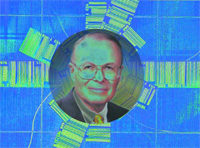it's about time (and space): interview with Ken Ackerman

Some guys run off and join the Peace Corps. Some pull a few strings and land a cushy government post. Others return to school, where they can spice up their graduate seminars with first-person accounts of life in the corporate trenches. A few finagle some funding and launch a dot-com … or a magazine. Somewhere down the line—often decades into a very successful career—many professionals find themselves at a crossroads, a mid-career junction (crisis would be too strong a word) where they simply want to do something else.
Twenty years ago, Ken Ackerman found himself in such a position. The head of Distribution Centers Inc., a logistics services company with operations in eight metro areas, Ackerman longed for a change. "I didn't want to spend my whole career in the corporate world," he says.
His thoughts first turned to education—but more in a Michael Hammer way than a Mr. Chips. "I decided that teaching big kids would be more fun than teaching little kids," says the Ivy League-educated professional, "and that, after all, is what consulting is all about."
Ackerman's first leap didn't take him too far from Corporate America. He cashed out his interest in Distribution Centers Inc. and spent the following year—which he describes as both "fabulous" and "life-changing"—as a consultant in the logistics practice of Coopers & Lybrand (now part of PricewaterhouseCoopers). Although he stayed there for only a year, the experience did two things for Ackerman. First, it confirmed for him that consulting was what he wanted to do. Second, it allowed him to learn the ropes of the consulting trade. "I had a chance to go to West Point before I committed to joining the Army," he quips.
With experience as both a practitioner and as a consultant under his belt, he launched The Ackerman Company, which is today widely considered one of the premier small consulting houses in the supply chain field.
In the 20-plus years since,Ackerman has both observed and lobbied for many of the advances that have changed the way logistics professionals do their work. In a late March conversation with DC VELOCITY Editorial Director Mitch Mac Donald, Ackerman reflected on the changes he has seen and on what's in store for us next.
Q: Let's stay on the block and tackle subject for a moment. The efficient use of space is important. Moving things in and out quickly, safely and damage free is important. What else is important? If a stranger were to walk up to you and say, "Hey, what are the three or four most important elements in a good warehousing or distribution center operation?" how would you answer?
A: Ah, the elevator pitch. I would tell them they needed to be sure they were managing the space as well as it can be managed and managing time, which is the labor, as well as it can be managed. Is there some waste in the operation? Are there steps that shouldn't be there?
Q: How do you go about helping them identify that?
A: Well, with space, you go in and look at many things, and ask many questions. Are the aisles wider than they need to be? Are the staging areas excessive? Have you properly isolated the fast movers and stored them so they are easily accessible? Many facilities are a combination of a distribution center and a warehouse. As a result, you have to identify what will be moving through quickly and what you'll be storing for later use.
Q: Are you seeing a lot of companies that are trying to use their space for the dual purpose of warehouse storage and distribution?
A: Not very many, but there is opportunity there. That's how we make a living. There are a few companies that really have things figured out, and they're doing it. A lot more probably should be.
Q: Let's shift to the things you have observed that have driven change. Let's say you're a logistics professional and your job is overseeing your company's DC operations. What has made your job profoundly different today than it was, say, 15 years ago?
A: It is the information revolution.
Q: Are you talking about this parallel flow of goods and information and how they interrelate? How is that really changing the job? Are people more productive or are people able to make better decisions because they have more information? Or is there another side to this, with people becoming overwhelmed by information?
A: Both. I think if I look back at the last 20—some years, the biggest thing to come along has been automatic identification, specifically bar coding and scanning. The next big thing, which I believe will supplant and possibly replace scanning, is voice recognition in the DC. I was initially skeptical about voice—based technology, so I had to be shown. When I went and saw it in a wholesale grocery DC in northern Ohio, I was blown away. It is so much better than scanning.
Q: What are some of the inherent advantages of voice? Are we talking about a technology that can really change the game?
A: Yes, and I'll tell you why. Your hands are free with voice. You don't have to hold a scanner. You don't have to hold any papers . You run down the aisle we a ring your earphones, your microphone and a computer attached to your belt, and you pick orders. The machine says, 'Go to X-70'; you say, 'I am at X-70 and I see queue #1234'; it says, Pick six pieces'; you say, 'Six , five, four, three, two, one, check'; and it tells you to proceed to the next location. It's programmed to check the count, too—which means better accuracy. The wholesale grocer that I saw doing it bought this system to improve accuracy; it did not buy it to boost productivity. Getting both was a pleasant surprise.
Q: It seems that a lot of emerging technologies that have made a huge difference in DC and logistics operations have come out of retail— especially the grocery and apparel businesses. Is that the case?
A: I'd say that's accurate, although we've seen some solid breakthroughs come out of the chemicals industry, as well. Overall, though, I think you're right. When they see a solid return in accuracy, or productivity, or both, folks in those industry segments aren't afraid to make an investment. The vice president of logistics at [the grocery chain] Kroger told me last summer that his company was going to put voice recognition in as quickly as it could get the money. He also told me that Wal-Mart was heading in the same direction. So here are two of the world's biggest retailers, both committed to this technology.
Another important point to make regarding voice-recognition technology is that the training is ridiculously easy. You can literally train an order picker in a few minutes. An order picker I observed in a Lima, Ohio, DC was a Teamster member. He had no motivation whatsoever to put on a show for me, but he did. That is what really blew me away—how fast this kid moved.
Q: So, rather than warily approaching this new technology, some workers are actually embracing it to make their workplace better?
A: Some of the folks who have spent more time on it than I have tell me that it actually reduces employee turnover. The young people who are using it think it is really cool and they are glad to be part of something that is really sophisticated.
Q: Let's look into the crystal ball a bit. You touched on some of the fundamentals that haven't changed in 20 years. You touched on some of the changes technology has brought to the DC. But where will the industry be in five or 10 years?
A: Thats a tough question. I recently wrote an article with George Gecowets, the retired head of the Council of Logistics Management, in which we identified eight developments that will change things in the coming years—some in a big way, some in a small way. Basically, the eight things are as follows: a greater emphasis on systems and flow in measuring performance; greater use of artificial intelligence; branding in the supply chain; simplified released-rate pricing to eliminate liability hassles; more pap erless and almost laborless operations; more emphasis on worker education and training; consolidation to two types of freight carriers, linehaul and last mile; and federal involvement in rebuilding the transportation infrastructure, particularly as the railroad rights of way become national property.
Related Articles

Copyright ©2024. All Rights ReservedDesign, CMS, Hosting & Web Development :: ePublishing